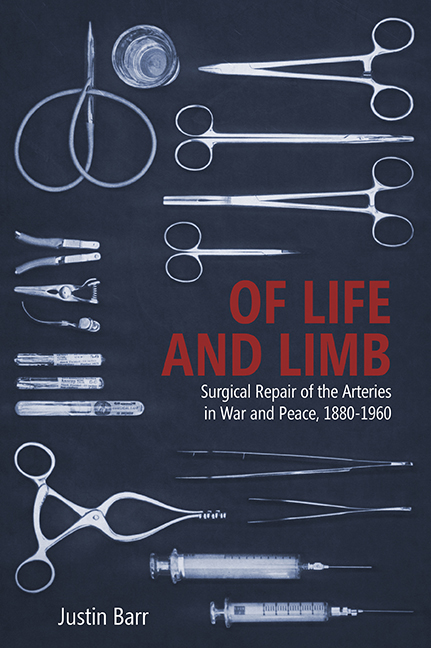 Surgical Repair of the Arteries in War and Peace, 1880–1960
Surgical Repair of the Arteries in War and Peace, 1880–1960 Book contents
- Frontmatter
- Contents
- Acknowledgments
- Introduction
- 1 Technical Change, Practical Stasis: The Development of Arterial Repair through 1914
- 2 An Ideal Rarely Practiced: Arterial Repair and Its Alternatives from World War I to World War II
- 3 Opportunities Realized and Discarded: The Management of Vascular Trauma in World War II
- 4 Reshaping Surgical Infrastructure between World War II and the Korean War
- 5 An Ideal Implemented: Arterial Repair in the Korean War
- 6 Bringing It All Back Home
- Conclusion: Arterial Repair and the Process of Surgical Change
- Notes
- Bibliography
- Index
2 - An Ideal Rarely Practiced: Arterial Repair and Its Alternatives from World War I to World War II
Published online by Cambridge University Press: 29 March 2020
- Frontmatter
- Contents
- Acknowledgments
- Introduction
- 1 Technical Change, Practical Stasis: The Development of Arterial Repair through 1914
- 2 An Ideal Rarely Practiced: Arterial Repair and Its Alternatives from World War I to World War II
- 3 Opportunities Realized and Discarded: The Management of Vascular Trauma in World War II
- 4 Reshaping Surgical Infrastructure between World War II and the Korean War
- 5 An Ideal Implemented: Arterial Repair in the Korean War
- 6 Bringing It All Back Home
- Conclusion: Arterial Repair and the Process of Surgical Change
- Notes
- Bibliography
- Index
Summary
The carnage of World War I initially provided hope that arterial repair might emerge from the shadows of the ivory tower and enter common practice. Battles resulted in thousands of patients in dire need of vascular surgery. Doctors deployed to the front lines aware of the possibilities of anastomosis. By 1917, military command strongly advocated for repair over ligation. The stalemate of trench warfare enabled the establishment of semipermanent hospitals, which facilitated complex interventions. Still, these operations remained exceptionally rare despite the efforts of a few pioneers. The same conditions that proved promising to the broad application of arterial repair simultaneously undercut its utilization, as millions of casualties overwhelmed meagerly trained medical providers desperately trying to stave off infection and save the lives of their patients, often at the cost of their limbs.
The practice of vascular surgery did not change significantly during World War I, but the results of this conflict stimulated a series of developments. First, recognizing that the practice of surgery had outpaced the competency of general practitioners, leaders of the American profession initiated coordinated efforts to reform, advance, and standardize surgical education into a universal, residency-based system. This process began to create a separate class of physicians who dedicated their professional careers to surgery. Second, exciting new laboratory discoveries such as the blood-thinning drug heparin and the X-ray technique of arteriography promised to facilitate arterial repair and catalyze its postwar adoption. Lastly, a new procedure called sympathectomy came to the fore. Technically simpler than anastomosis, with outcomes reportedly superior to plain ligation, sympathectomy became the face of vascular surgery in the 1930s.
This chapter continues to explore the paradoxical non-adoption of a well-known surgery that almost everyone agreed produced better results for patients. If World War I demonstrated the power of environment to encourage or hinder the practice of surgery, then the years between that war and the next represented concerted social and scientific efforts to change those conditions and make them more amenable to the implementation of advanced operations generally and arterial repair specifically.
World War I: The Persistence of Ligation
The Serbo-Turkish and Serbo-Bulgarian Wars in which Vojislav Soubbotitch fought and repaired arteries foreshadowed World War I, a military and cultural clash that encompassed much of the world. Devastating new killing technologies tormented the battlefield.
- Type
- Chapter
- Information
- Surgical Repair of the Arteries in War and Peace, 1880–1960Surgical Repair of the Arteries in War and Peace, 1880–1960, pp. 40 - 65Publisher: Boydell & BrewerPrint publication year: 2019


